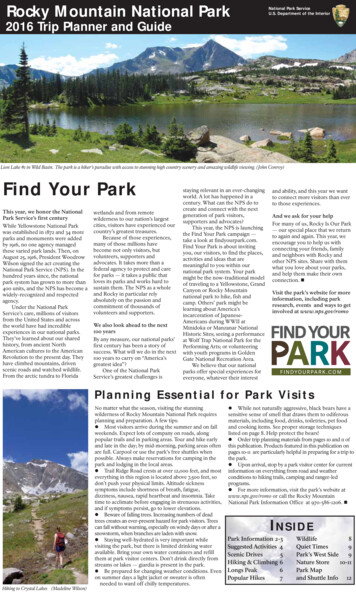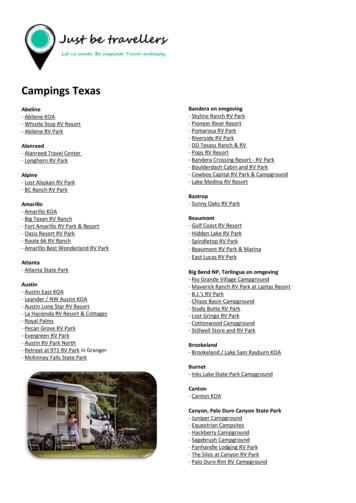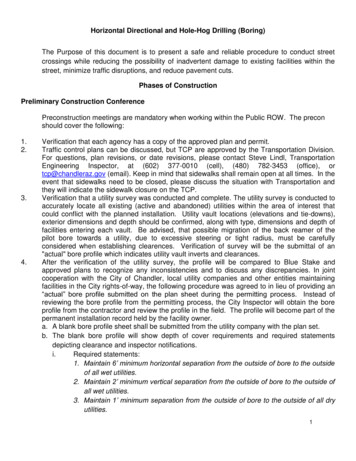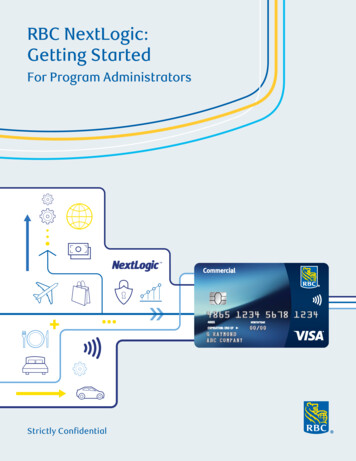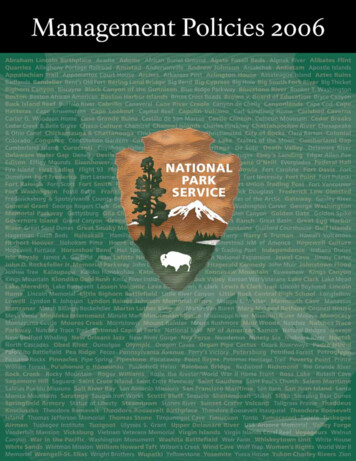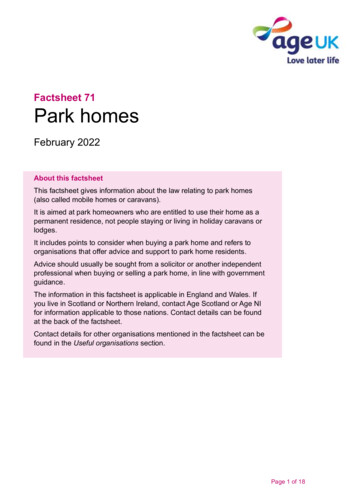
Transcription
National Park ServiceU.S. Department of the InteriorGrand Canyon National ParkGrand Canyon, Arizona2021 Park ProfileAuthorization1882: First unsuccessful attempt to establish a Grand Canyon National Park1893: Designated a “forest reserve” by President Benjamin Harrison (Presidential Proclamation #45)1908: Establishment of Grand Canyon National Monument by President Theodore Roosevelt (Presidential Proclamation #794)1919: Designated as Grand Canyon National Park by an act of Congress on February 26 (40 Stat 1175)1965: Designated as Kaibab Squirrel Natural Landmark by Interior Secretary Stewart Udall (North Rim and Kaibab Plateau)1975: Grand Canyon National Park Enlargement Act enacted by Congress on January 3 (88 Stat 2089) (Public Law 93-620)1979: Designated a World Heritage Site on October 262013: Designated as a Globally Important Bird and Biodiversity Area by BirdLife International2019: Designated an International Dark Sky Park (IDSP) by the International Dark-Sky AssociationPark StatisticsGrand Canyon National ParkPark Size:1,218,375 acres (493,059 ha)1,904 square miles (4,931 km2)Length: 278 river miles (447 km)Width:Minimum at Marble Canyon, 600 feet (180 m)Average Rim to Rim: 10 miles (16 km)Maximum Rim to Rim: 18 miles (28.8 km)Depth: Average 1 mile (1.6 km)Elevations:South Rim 7,000 feet (2,100 m)North Rim 8,000 feet (2,400 m)Volume: 5.45 trillion cubic yards (4.17 trillion m3)Colorado River in Grand Canyon National ParkLength: 278 miles (447 km)Average Width: 300 feet (90 m)Minimum Width: 76 feet (23 m)Average Depth: 40 feet (12 m)Greatest Depth: 85 feet (25.5 m)Average Gradient: 7 feet per mile (1.3 m/km)Elevation at Phantom Ranch: 2,400 feet (720 m)The Colorado River is 1,450 miles (2,333 km) long from its source inthe Rocky Mountains of Colorado to the Gulf of California.
GeologyGrand Canyon National Park preserves an iconic geologiclandscape and resources ranging from 1.8 billion (PreCambrian) year-old igneous and metamorphic rocks to230 million (Triassic)-year-old sedimentary rocks, 5 million(Pliocene)-year old to recent volcanic deposits, a complextectonic and erosional history, and unconsolidated surfacedeposits.The Colorado River established its course through thecanyon approximately 6 million years ago and likely evolvedfrom pre-existing drainages to its current course. Geologicprocesses, including erosion of tributaries and slopes, andactive tectonics continue to shape the canyon today. Thegeologic record in Grand Canyon is an important scientificchronicle and is largely responsible for its inspirationalscenery.Palentology resources include nearly 300 diverse andglobally significant fossil localities ranging from 1.2-billionyear-old stromatolites to Paleozoic trilobites, plants,reptile tracks, and marine invertebrates, and Pleistocenemegafauna in caves.Plant and Animal LifeAnimalsVegetation FormationsBirds: 450 speciesMammals: 91 speciesFish: 18 species, 5 nativeReptiles and Amphibians: 58 speciesInvertebrates: 1,443 species, including 292 butterflies andmothsExotic (non-native) animals: 30 speciesPark Endemic animals, not extirpated: 9 species; 5butterflies, 1 pseudoscorpion, 1 tarantula, 1 snake, 1molluskRegionally Endemic animals, not extirpated: 5 species;humpback chub, razorback sucker, flannelmouthsucker, Kaibab squirrel, and the Navajo Mexican voleOne reptile, three mammal, and one mollusk species areknown only from the Grand Canyon region. At least ninespecies of insects are endemic to Grand Canyon, and sixfish species are endemic to the Colorado River basin.PlantsVascular Plants: 1,747 speciesEndemic Plants: 4 speciesExotic (non-native) Plants: 208 species2 Grand Canyon National ParkPark Profile6 types: riparian, desert scrub, pinyon/juniper woodland,ponderosa pine forest, spruce/fir forest, and mals: California condor, humpback chub, razorbacksucker, southwestern willow flycatcher, Mexican spottedowl, Ridgway’s rail, yellow-billed cuckoo, and deserttortoise. There are over 35 species of special concern.Plants: The sentry milk-vetch (Astragalus cremnophylaxvar. cremnophylax) is the only endangered plant in thepark. There are no listed threatened plant species. Ninespecies of special concern (formerly category 2 species)are known, and 25 additional vascular plants are ofmanagement concern due to their limited distribution.Extirpated SpeciesGrizzly bear, black-footed ferret, gray wolf, jaguar, BearValley sandwort, Colorado pikeminnow, bonytail,roundtail chub, and southwestern river otter.
Human HistoryThe oldest human artifacts found date to the Paleoindianperiod and are nearly 12,000 years old. Since that time,various cultures have continually used and occupied landsthat became the park. Archaeological evidence from thefollowing prehistoric culture groups is found in GrandCanyon National Park: Paleoindian, Archaic, Basketmaker,Ancestral Puebloan (Kayenta and Virgin branches),Cohonina, Cerbat, Pai, and Southern Paiute. Historical-periodcultural groups include the Hopi, Navajo, Pai, SouthernPaiute, Zuni, and Euro-American.There are currently 3,391 ancestral sites documented withinthe park dating to the prehistoric period, representingapproximately 7% of park lands inventoried. In addition,park records document evidence of historic period use from1540-1950, including 453 locations with evidence of historicNative American use.Tribal PartnersGrand Canyon is home to 11 federally recognized tribes withdeep history and connection to the Grand Canyon sincetime immemorial. Tribal governments and communitieswork closely with park administration and managementon a host of programs. Through collaborative projectssuch as the Desert View Watchtower Intertribal CulturalHeritage Site, the park is working with tribes to provideaccurate and culturally appropriate information tovisitors. This “First Voice” programming acknowledgesthe rich and diverse culturalhistory of the Grand Canyonand celebrates the connectionsnative people have to the Canyon.Tribal lands surrounding thepark offer many unique tourismopportunities to visitors planning atrip to the Grand Canyon.Historic ResourcesNational Historic LandmarksIndividual Buildings: 4Districts: 3Sites: 1National Register of Historic PlacesNational Register properties include archaeological sites,historic structures, cultural landscapes, and ethnographicresources. The park is working with the University of Arizonaand tribes to prepare a nomination for the Grand Canyon asa Traditional Cultural Place. The work will be completed in2022.List of Classified Structures (LCS): 874Buildings: 8Districts: 10Sites: 2Structure: 1LCS includes National Historic Landmark and NationalRegister listed or eligible properties.Cultural Landscapes: 16ClimateClimate in Grand Canyon National Park is relatively mild.However, low humidity generally allows large temperaturedifferences between day and night.South RimSince precipitation totals are low, year-to-year variationscan be large. The passage of a few major storms can have asignificant impact on the year’s total.North RimMean High Temperature-30 yrs: 64 F (17.8 C)Mean Low Temperature-30 yrs: 29.5 F (-1.4 C)Avg. Annual Precipitation-30 yrs: 13.4 inches (34.0 cm)Total Precipitation in 2021: 11.5 inches (29.2 cm)Mean High Temperature-30 yrs: 55 F (12.8 C)Mean Low Temperature-30 yrs: 31.7 F (-0.2 C)Average Annual Precipitation-30 yrs: 24 inches (62 cm)Total Precipitation in 2021: Too much missing dataPhantom RanchMean High Temperature-30 yrs: 81 F (27.2 C)Mean Low Temperature-30 yrs: 54.2 F (12.3 C)Average Annual Precipitation-30 yrs: 9.6 inches (24 cm)Total Precipitation in 2020: 8.49 inches (21.6 cm)3 Grand Canyon National ParkPark Profile
DevelopmentBuildingsRecreational Vehicle SitesTotal: 1,182National Park Service: 647Concessioners: 535Total: 123Visitor FacilitiesTrailsPaved: 35 miles (56.3 km)Unpaved: 560 miles (901.2 km)Total: 595 miles (957.6 km)RoadsPaved: 124 miles (199.6 km)Unpaved: 148 miles (238.2 km)Total: 272 miles (437.7 km)Sewage Treatment FacilitiesTotal: 4Trans-canyon Waterline (TCWL)Water from Roaring Springs to the North and South rimsTotal: 23 miles (37 km)Lodging UnitsVisitor centers, museums, theaters, backcountryoffices, historic structures, scenic overlooks, accessiblerim trails, lodging, campgrounds, dump stations,service stations, restaurants, cocktail lounges, coffeeshops, general stores, gift shops, bookstores, clinic,bank, post offices, churches, and a kennel. Somefacilities are seasonal.Visitor ServicesServices include educational exhibits, curriculumbased education programs, junior ranger programs,ranger programs and hikes, picnicking, bicycling, bikerentals, self-guided hikes, mule riding, backpacking,fishing, river trips, overnight lodging, camping, camperservices, guided bus tours, air tours (outside of park),shuttle bus service, taxi, auto repair, publication sales,gift and grocery sales, law enforcement, and medicaland emergency services.ConcessionersSouth Rim: 908North Rim: 219Phantom Ranch: 15In Fiscal Year 2021, 22 concessioners grossedapproximately 176 million and paid franchise and otherfees of approximately 16.5 million.Rim CampsitesMather: 317 family, 7 group, 2 hiker/biker, 2 livestockDesert View: 50 familyNorth Rim: 90 family, 3 groupTuweep: 9 family, 1 group2021 Visitor and Resource ProtectionLaw Enforcement ActivitiesPreventive Search and Rescue (PSAR)Total Number of Criminal Case Reports: 689Arrests: 43Part I Offenses Investigated: 10Part II Offenses Reported: 1,018Law Enforcement Jurisdiction: ConcurrentEmergency Medical ServicesEmergency Medical Service Incidents: 1,157Fatalities: 23Search and Rescue Incidents (SAR)Total: 4114 Grand Canyon National ParkPark ProfileTotal Contacts: 135,831Preventative Actions: 21,844Hiker Assists: 434Structural Fire Incidents and ResponsesTotal: 82Wildland Fire Incidents and TreatmentsFire Start Incidents: 14Acres treated with wild & prescribed fire: 1,091Acres of defensible space treated: 21
2021 VisitationTotal Visitation2021 Total: 4,550,9212020 Total: 2,897,098*2019 Total: 5,974,411Shuttle System Passengers2018 Total: 6,380,4952017 Total: 6,254,238Mule Trip Riders2,856,150 boardings (not passengers)The shuttle system was implemented in 1974. Year-roundshuttle service began March 10, 2000.Backcountry User NightsTotal: 85,656Corridor: 40,924Other Backcountry Trails: 44,732Backcountry permits issued: 12,904Backcountry permits used: 11,038Colorado River User DaysXanterra, South RimPhantom Ranch 1 night: 1,823Phantom Ranch 2 nights: 325Canyon Vistas: 10,146Canyon Trail Rides, North RimOne Hour Rim Ride: 3,664Half Day Inner Canyon Ride: 4,588Half Day Rim Ride: 1,027Train PassengersNorth-bound boardingsTotal: 164,588Lees Ferry to Diamond CreekCommercial: 132,991Noncommercial: 113,674*Park closure April-May 2020 due to the COVID-19 pandemicDiamond Creek to Pearce FerryNoncommercial: 14,7232021 Interpretive Services and ActivitiesVisitor Centers and Contact StationsGrand Canyon Visitor CenterVerkamp’s Visitor CenterYavapai Observation StationTusayan Ruin and Museum-Closed in 2021Desert View Visitor CenterNorth Rim Visitor CenterKolb StudioIndian GardenPhantom RanchHeadquarters-Closed to the public in 2021Interpretive Walks, Talks, and Programs201 programs to 7,764 visitorsEnvironmental Education Programs67 programs to 1,732 participants (distance learning)5 Grand Canyon National ParkPark ProfilePrint PublicationsPark Unigrids/maps distributed on the South Rim: 757,350Pocket Map and Services Guide distributed on the SouthRim: 1,050,000All other brochures: 249,000Pocket Map and Services Guide available in eight languages.Digital and Social MediaFacebook followers: 674,026Instagram followers: 833,846Twitter followers: 195,191Total nps.gov/grca page views: 17,786,965Survey of customer satisfaction with GRCA website:82.6% (NPS average customer satisfaction:81.5%)
AdministrationFY 2021 FundingNational Park Service Staffing—FY 2021Operation of the National Park System (ONPS)ONPS Base Operating Appropriation: 22,568,474ONPS Non-base Funding: 101,500Special Emphasis Program Allocation (SEPAS)FirePro Base: 1,601,032Construction and Major Maintenance: 580,523Repair and Rehabilitation: 3,825,368Federal Lands Recreation Enhancement Act—80% portion(FY-12) 13,972,969(FY-13) 14,775,466(FY-14) 8,407,057 (collections reduced by LSI buy down)(FY-15) 18,361,846(FY-16) 15,215,281 (collections reduced by Pipeline reserve)(FY-17) 11,739,334 (collections reduced by Pipeline reserve)(FY-18) 16,263,449(FY-19) 15,788,360(FY-20) 16,411,907(FY-21) 15,021,494Federal Lands Highway Program: 1,807,086Income 2021Utilities Reimbursable: 3,519,610Quarters: 1,888,559Concession Franchise Fees—20% Portion: 2,411,984Filming and Location Fees: 1,980Donations (monetary): 1,567,897Transportation (Shuttle Buses): 5,194,821Other (reimbursable, refundable, etc.): 1,281,3966 Grand Canyon National ParkPark ProfileInformation and distribution of all staff (Permanent, Term,and Seasonal).Superintendent’s Office: 16Administration: 28Science and Resource Management: 55Commercial Services: 15Planning, Environment, and Projects: 14Facility Management: 133Interpretation: 71Visitor and Resource Protection: 210Fire and Aviation Management: 42Total National Park Service Staffing(FY-17) 382(FY-18) 452(FY-19) 372(FY-20) 503(FY-21) 584Volunteers-in-Parks (VIP) ProgramVolunteer hours by categoryAdministration: 743.75Campground Host: 6,354.5Cultural Resource Management: 178.25Interpretation/Education: 726.5Natural Resource Management: 6,061Protection/Law Enforcement: 19,559In-Kind Service AmountTotal volunteers in park: 219Total hours: 33,623National value of each volunteer hour: 28.54Total in-kind services: 959,600.42
Partnerships and External AffairsGateway Communities & CountiesFlagstaff, AZFredonia, AZJacob Lake, AZKanab, UTTusayan, AZWilliams, AZCoconino County, AZGarfield County, UTKane County, UTMohave County, AZPhilanthropic & Community PartnersGrand Canyon ConservancyNational Park FoundationArizona Trail AssociationGrand Canyon River GuidesGrand Canyon Music FestivalArizona Congressional RepresentativesSenator Kyrsten SinemaSenator Mark KellyFirst District Representative-Tom O’HalleranFourth District Representative-Paul GosarWashington County, UTTraditionally Associated American Indian TribesHavasupai Tribe, AZHopi Tribe, AZHualapai Tribe, AZKaibab Band of Paiute Indians, AZLas Vegas Band of Paiute Indians, NVMoapa Band of Paiute Indians, NVNavajo Nation, AZPaiute Indian Tribe of Utah, UTSan Juan Southern Paiute Tribe, AZThe Pueblo of Zuni, NMYavapai-Apache Nation, AZSuperintendentEd KeableMedia ContactPublic Affairs Office928-638-7779Park Information928-638-7888State and Federal PartnersArizona Game and Fish Department, AZBryce Canyon National Park, UTBureau of Land Management, AZ/UTBureau of ReclamationFlagstaff Area National Monuments, AZGlen Canyon National Recreation Area, UT/AZGrand Canyon Parashant National Monument, AZKaibab National Forest, AZLake Mead National Recreation Area, AZPipe Spring National Monument, AZU.S. Geological SurveyVermilion Cliffs National Monument, AZZion National Park, UT7 Grand Canyon National ParkPark ProfileWebsitewww.nps.gov/grcaAddressGrand Canyon National ParkP.O. Box 129Grand Canyon, AZ 86023-0129 USA
park size: 1,218,375 acres (493,059 ha) 1,904 square miles (4,931 km2) length: 278 river miles (447 km) width: minimum at marble canyon, 600 feet (180 m) average rim to rim: 10 miles (16 km) maximum rim to rim: 18 miles (28.8 km) depth: average 1 mile (1.6 km) elevations: south rim 7,000 feet (2,100 m) north rim 8,000 feet (2,400 m) volume: 5.45
